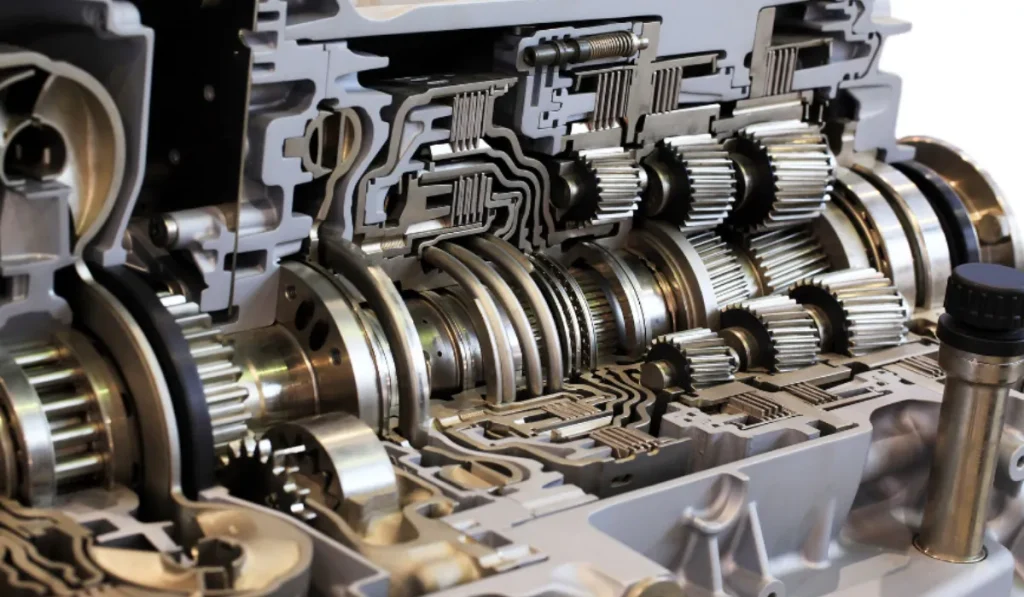The weight of a transmission varies from roughly 100 to 400 pounds (45 to 181 kilograms), depending on the vehicle type. Car transmissions are generally towards the lighter end, while truck transmissions weigh more.
Exploring the specifics of transmission weights is crucial for mechanics and automotive enthusiasts alike.
Transmissions are key components in vehicles, responsible for transferring engine power to the wheels.
The weight of a transmission can impact fuel efficiency, handling, and overall vehicle performance.
Lighter transmissions are typically found in smaller cars where the need for efficiency and agility is greater.
Heavy-duty trucks, on the other hand, require robust transmissions that can handle higher torque loads, thus increasing their weight.
Knowing the weight is also vital for safe handling during repairs or replacements. This information empowers vehicle owners and technicians to plan for a smooth and secure installation or removal process.

The Weight Of A Transmission
Understanding the weight of your vehicle’s transmission is crucial for mechanics and car enthusiasts alike.
The transmission is a pivotal component that plays a key role in your vehicle’s ability to drive. Different types can have a significant impact on performance and fuel efficiency.
Variations Based On Transmission Type
Transmissions come in various shapes and sizes. Each type affects the overall weight differently.
- Manual transmissions tend to be lighter than their automatic counterparts.
- Automatic transmissions often weigh more due to additional parts.
- Continuously Variable Transmissions (CVTs) offer a middle ground in terms of weight.
| Type of Transmission | Approximate Weight Range |
|---|---|
| Manual | 100-200 lbs (45-91 kg) |
| Automatic | 150-250 lbs (68-113 kg) |
| CVT | 125-200 lbs (57-91 kg) |
Impact Of Material And Design Choices
The material and design of a transmission significantly affect its weight.
Aluminum casings can reduce weight, improving fuel efficiency.
Heavier steel components provide durability at the expense of added weight.
Innovative designs aim to balance strength and weight for optimal performance.
- Lighter materials often lead to less strain on the engine.
- Durability must not compromise with the weight reduction.
- Automakers strive for a blend of efficiency and endurance.
Factors Influencing Transmission Weight

Understanding how heavy a transmission is requires looking at various factors. These factors shape the weight and functionality of a transmission.
It’s crucial for automotive enthusiasts and professionals to know these details. They help in maintenance, repairs, and when opting for a new transmission system.
Size And Complexity Differences
The size and complexity of a transmission play a key role in its weight. Here are the main points:
- More gears mean more weight.
- A larger vehicle will have a heavier transmission.
- Manual transmissions can be lighter than automatic ones.
- Dual-clutch systems may add to the total weight.
Consider the difference between a small car and a large truck. The truck’s transmission handles more torque and workload. Thus, it is often heavier.
Material Composition: Metals And Alloys
Transmission weight also depends on the materials used. Here’s a quick overview of common materials:
| Material | Properties | Effect on Weight |
|---|---|---|
| Aluminum | Lightweight, corrosion-resistant | Reduces weight |
| Steel | Strong, durable | Increases weight |
| Magnesium Alloys | Very light, strong | Reduces weight significantly |
Aluminum is popular in modern transmissions for its strength-to-weight ratio. Steel remains common in older or heavy-duty transmissions.
Magnesium alloys offer lightness but at a higher cost.
Transmission Types And Their Typical Weights
Transmissions play a pivotal role in your vehicle’s performance. Different types of transmissions can vastly differ in weight.
This variation affects your car’s efficiency, fuel economy, and handling. Let’s dive into the typical weight ranges for both manual and automatic transmissions to understand these differences better.
Manual Transmission Weight Range
Manual transmissions, known for their durability and control, generally weigh less than their automatic counterparts.
The weight of a manual transmission varies based on the number of gears and the vehicle’s size. Here’s a quick look at the weight range you can expect:
- Small cars: Approximately 100 to 120 pounds
- Sedans and small trucks: Around 120 to 180 pounds
- Heavy-duty trucks: Can reach up to 300 pounds
Automatic Transmission Weight Spectrum
Automatic transmissions offer convenience and ease of use. They pack more complexity, which means they also pack more pounds.
The weight of an automatic transmission includes the torque converter and the intricate components enclosed within. Typically, you’ll find the following weights:
| Vehicle Type | Weight Range |
|---|---|
| Compact cars | 150 to 190 pounds |
| Mid-size cars | 180 to 220 pounds |
| Full-size trucks/SUVs | 210 to 450 pounds |
Remember, these figures are estimates and can vary between different models and manufacturers.
Role Of Weight In Vehicle Performance

Understanding the weight of a transmission is vital. It affects your car’s overall performance.
Heavier transmissions can change how your car drives. Lighter ones can improve your car’s speed and efficiency. It’s crucial to balance transmission weight for optimal vehicle performance.
Fuel Efficiency And Load
Let’s dive into how transmission weight impacts fuel efficiency. A heavy transmission means your engine works harder. This burns more fuel.
Reducing weight can help you save at the gas station.
- Less weight means better fuel economy.
- Extra load can lead to higher fuel costs.
Manufacturers aim for a balance. They want strong transmissions that don’t waste fuel. We see this in the shift towards lighter materials in design.
Acceleration And Handling Dynamics
Weight directly relates to acceleration and handling. A lighter transmission can mean a faster car.
It’s easier for the engine to move a lighter vehicle. This gives you a quicker acceleration. Handling gets better, too. A lighter load means a car that’s easier to control.
- Quick start: Lighter cars have less drag.
- Better handling: Easy turns and stops with less weight.
Car makers work hard to reduce transmission weight. This helps improve both acceleration and handling.
Hence, a balanced transmission design is key for a great driving experience.
Innovations In Transmission Technology
Transmissions play a crucial role in vehicle performance. Yet, they can be heavy. Advanced technology strives to reduce weight while maintaining efficiency.
Lighter transmissions lead to better fuel economy and handling. Now, let’s explore recent breakthroughs in this essential auto component field.
Lightweight Materials And Future Trends
Car makers are turning to lighter materials to shave pounds off transmissions. What was once cast iron may now be aluminum or even composite materials.
These innovations are not just about using new substances. They also involve redesigning transmission parts for optimal strength with less bulk.
- Magnesium Alloys: Exceptionally light yet strong.
- Carbon Fiber: Used more in high-performance vehicles.
- 3D Printed Components: Future potential to reduce weight further.
Future trends show a move towards even more exotic materials and smart designs. These advancements suggest exciting possibilities for further weight reduction.
Success In Reducing Transmission Weight
Several car manufacturers have showcased successful weight reduction in their transmission systems. Here’s how they achieved impressive results:
| Manufacturer | Transmission Type | Weight Saved | Material Used |
|---|---|---|---|
| Ford | 10-Speed Automatic | 20 lbs | Aluminum |
| GM | 9-Speed Automatic | 15 lbs | Composite Materials |
| BMW | 7-Speed Dual-Clutch | 18 lbs | Magnesium Alloys |
These case studies highlight the significant impact of light-weighting. Each example shows a commitment to better fuel efficiency and performance.
By reducing transmission weight, these companies set new industry standards.
Practical Considerations When Handling Transmissions
When you’re dealing with a car’s transmission, you’re handling a vital yet hefty component. The weight of transmissions can vary widely, but on average, you’re looking at anywhere from 100 to 400 pounds.
Knowing this, safety and proper procedures become paramount whenever you transport or work on this critical piece of machinery.
Proper Lifting Techniques
Managing the weight of a transmission is no small feat. Before any lifting begins, ensure you have a clear path to your destination.
Sturdy shoes with grip can prevent slips, and tight-fitting gloves can improve your hold on the equipment. The spine should stay straight while lifting, and knees should bend, not your back.
Always lift with a partner if the transmission’s weight exceeds your personal limit, which is often anything above 50 lbs. Working in pairs not only divides the load but also adds to the safety factor.
Tools And Equipment For Heavy Lifting
For the successful and safe relocation of a transmission, the right tools make all the difference. A transmission jack is essential for supporting and maneuvering heavy transmissions.
Additionally, considering engine hoists can also be a smart choice. Don’t forget about using durable lifting straps or chains when securing transmissions to hoists.
- Transmission Jack
- Engine Hoist
- Lifting Straps/Chains
A workbench at the proper height can save your back, while a rolling cart makes it easier to move transmissions without having to lift them constantly.
Use these tools with care, follow the manufacturer’s recommendations, and never exceed their weight limits.
FAQs About the Weight of a Transmission
What Is The Average Weight Of A Transmission?
The average weight of a car transmission is about 150 to 220 pounds. Specific weight depends on the vehicle type, model, and whether the transmission is manual or automatic.
Truck transmissions are significantly heavier, potentially exceeding 700 pounds.
How Does Transmission Weight Affect Vehicle Performance?
Transmission weight can influence vehicle acceleration, fuel efficiency, and handling.
Heavier transmissions might lower acceleration speeds and reduce fuel economy, but are often associated with durability and the ability to handle higher torque loads in larger vehicles.
Can Transmission Weight Vary By Car Model?
Yes, transmission weight varies by car model and make. Compact cars have lighter transmissions, often below 150 pounds, while full-sized vehicles feature heavier ones, reaching beyond 200 pounds.
Luxury and performance vehicles might have specialized transmissions with unique weight characteristics.
What’s The Difference In Weight Between Manual And Automatic Transmissions?
Manual transmissions usually weigh less than automatic ones, often by 50 to 100 pounds.
The complex mechanisms in automatic transmissions, like torque converters and hydraulic pumps, add to the overall weight compared to simpler manual systems.
Conclusion
Wrapping up, the weight of a transmission varies greatly. From compact cars to hefty trucks, it ranges from about 100 pounds to over 400. Knowing this is critical for repairs, shipping, and performance tuning.
Always consider vehicle specifications for accurate measures, ensuring safe and effective handling.
Keep informed, and handle your transmission with care.
Resources:
https://www.cdc.gov/infectioncontrol/basics/transmission-based-precautions.html
https://www.oregon.gov/oha/ph/diseasesconditions/communicabledisease/pages/transmission.aspx
